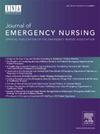开发和测试一种多模式干预措施,以减少急诊科的暴力行为并提高安全感:纵向研究。
IF 2.3
4区 医学
Q2 EMERGENCY MEDICINE
引用次数: 0
摘要
病人和来访者的暴力和对急诊科临床医生的攻击是一个复杂的现象,需要多方面的方法和认识到干预措施需要时间来整合到实践中。本研究的目的是确定多模式干预对一个急诊科工作场所暴力事件频率和临床医生安全感知的有效性。方法:采用准实验、纵向设计来回答研究问题。实施了环境变化、包括快速降级程序在内的算法响应指南,以及改进正式的事件报告系统。参与者完成了一项在线匿名调查,其中包括人口统计信息、急救护士个人工作场所安全工具,以及实施之前和实施后三个季度的暴力和攻击频率清单。结果:向所有140名急诊科临床医生发送了调查问卷。应答率在基线时最高,但随着时间的推移而降低。临床医生在研究期间经历的事件数量没有显著差异。在研究过程中,对安全的认知从基线下降,但提交的正式事故报告数量显著增加。讨论:尽管付出了巨大的努力,但很难减少患者和来访者的暴力和攻击行为,也很难提高急诊科临床医生对急诊科安全的认识。暴力和攻击性行为的时机和严重程度可能会影响结果。需要做更多的工作,使用不同的研究、实施和评估方法,以确定在急诊科预防脊髓灰质炎的最佳做法。本文章由计算机程序翻译,如有差异,请以英文原文为准。
Developing and Testing a Multimodal Intervention to Decrease Violence and Increase Perceptions of Safety in the Emergency Department: A Longitudinal Study
Introduction
Patient and visitor violence and aggression against emergency department clinicians is a complex phenomenon requiring a multifaceted approach and recognition that interventions require time to integrate into practice. The purpose of this study was to determine the efficacy of a multimodal intervention on frequency of workplace violence incidents and clinicians’ perceptions of safety in one emergency department.
Methods
A quasi-experimental, longitudinal design was used to answer study questions. Environmental changes, an algorithmic response guideline that included a rapid de-escalation program, and improvements in the formal incident reporting system were implemented. Participants completed an online, anonymous survey that included demographic information, the Personal Workplace Safety Instrument for Emergency Nurses, and a violence and aggression frequency checklist prior to and for three quarters following implementation.
Results
Surveys were sent to all 140 emergency department clinicians. Response rate was highest at baseline but decreased over time. There was no significant difference in number of incidents experienced by clinicians during the study. Perceptions of safety decreased from baseline during the course of the study, but there was a significant increase in the number of formal incident reports submitted.
Discussion
Despite significant efforts, it was difficult to decrease violent and aggressive acts committed by patients and visitors and to improve emergency department clinicians’ perceptions of safety in the emergency department. Timing and severity of violent and aggressive acts may have influenced results. More work needs to be done using different research, implementation, and evaluation methods to determine best practices for preventing WPV in the emergency department.
求助全文
通过发布文献求助,成功后即可免费获取论文全文。
去求助
来源期刊
CiteScore
3.10
自引率
11.80%
发文量
132
审稿时长
46 days
期刊介绍:
The Journal of Emergency Nursing, the official journal of the Emergency Nurses Association (ENA), is committed to the dissemination of high quality, peer-reviewed manuscripts relevant to all areas of emergency nursing practice across the lifespan. Journal content includes clinical topics, integrative or systematic literature reviews, research, and practice improvement initiatives that provide emergency nurses globally with implications for translation of new knowledge into practice.
The Journal also includes focused sections such as case studies, pharmacology/toxicology, injury prevention, trauma, triage, quality and safety, pediatrics and geriatrics.
The Journal aims to mirror the goal of ENA to promote: community, governance and leadership, knowledge, quality and safety, and advocacy.

 求助内容:
求助内容: 应助结果提醒方式:
应助结果提醒方式:


